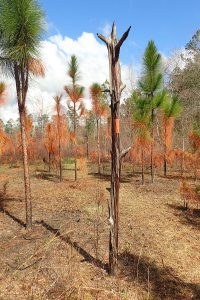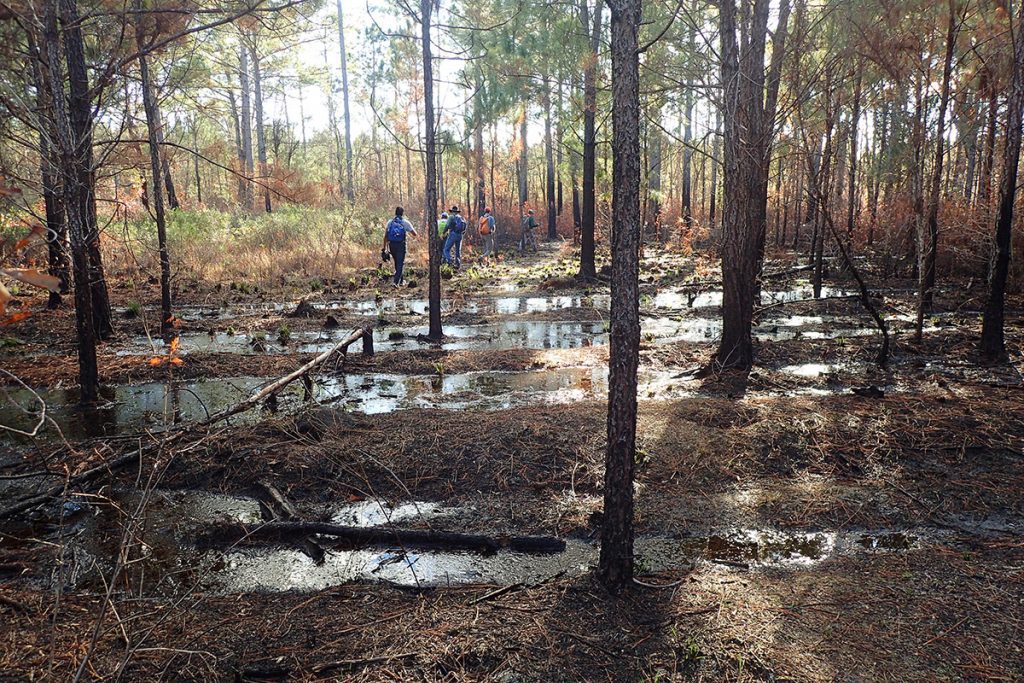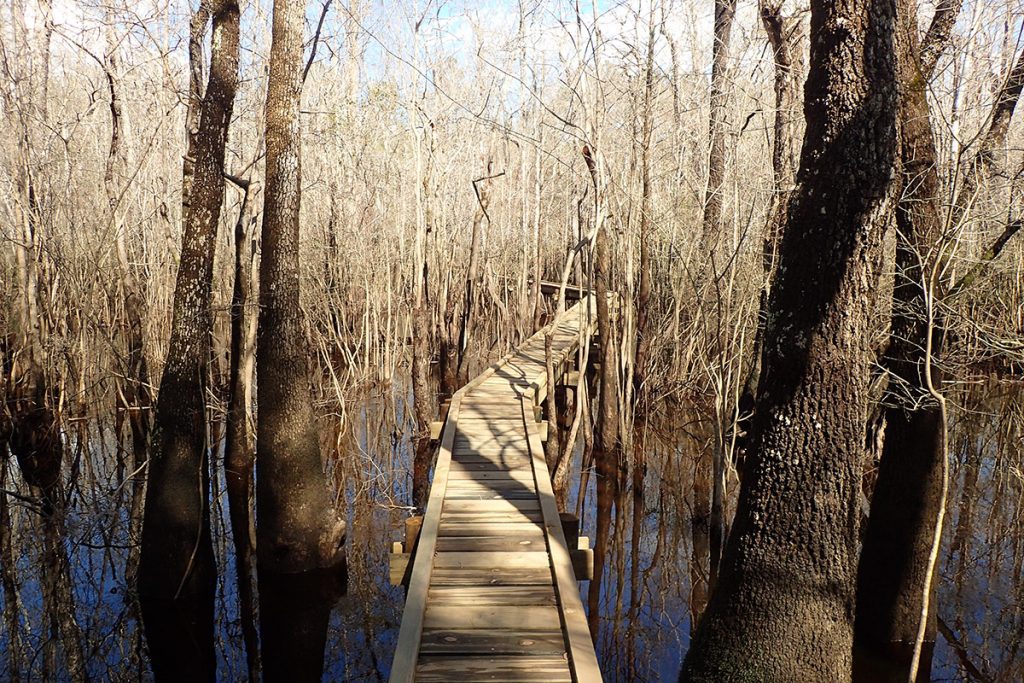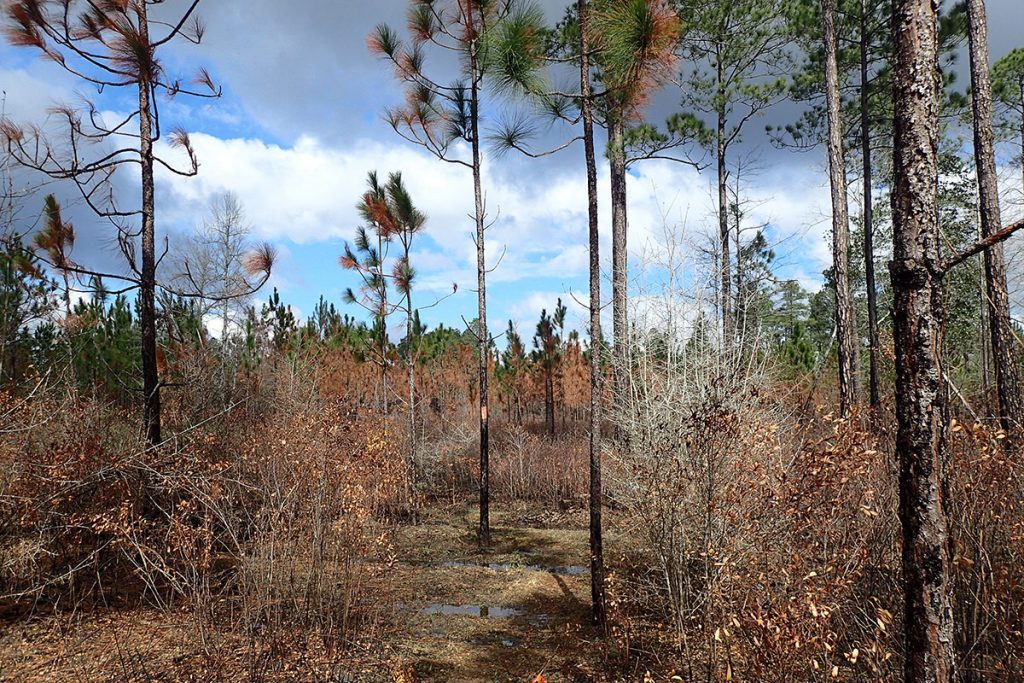We’re back on the Florida National Scenic Trail, this time on a new section along the Choctawhatchee River. Thanks to the Choctawhatchee Chapter of the Florida Trail Association for helping us out, and to Bruce Varner and Caroling Geary (of Wholeo.net) for providing photos and video of trail construction.
Tallahassee’s Hot Tamale composed some new music for this video. Thanks again Craig and Adrian for all you do for us!
Our hike by the Choctawhatchee River brims with newness. It’s not just that we get to hike a recently completed section of the Florida National Scenic Trail. That is, of course, pretty cool. That new trail takes us through recently burned forest, the beginning of a cycle of renewal in the longleaf ecosystem. Also, we’re passing through the Nokuse Plantation, where a massive restoration project is making the forest new again. It’s a nice coming together of environmental and recreational upgrades in Walton County.
We’re with Mary McKinley, Bruce Varner, and a group of trail volunteers. They represent the Choctawhatchee Chapter of the Florida Trail Association; Mary is the chapter president and Bruce is the section leader for the stretch we’re hiking. We’re passing though years of their hard work and planning. Bruce proudly points out a stand of thick vegetation they cut through. We pass over a small bridge they built and new signs hand made from fat lighter wood. The orange blazes marking the trail are bright and bold.
We start under the Highway 20/ Choctawhatchee River bridge. After a couple of hundred yards along the highway, we enter the forest. Originally, the Florida Trail continued for about ten miles along roadways from here; this section provides the unpaved experience hikers like.
Recent rains have left some good sized puddles to cross. Much of this land was on timber plantations, with loblolly and slash pine planted in raised rows. Even though it is being restored to the more ecologically correct longleaf pine, the raised rows remain. We splash our way through water that gathered between these berms.
We see a good variety of different Florida habitats in just a few miles. The recently burned longleaf habitat is full of younger trees; those who regularly hike the trail over the next few years will see this forest mature. We do see some of the trademarks of this ecosystem, such as gopher tortoise burrows and wiregrass. Wiregrass burns to the ground but , as we see on our hike, grows back soon after a fire.
After that stretch of dry upland, things get wetter.
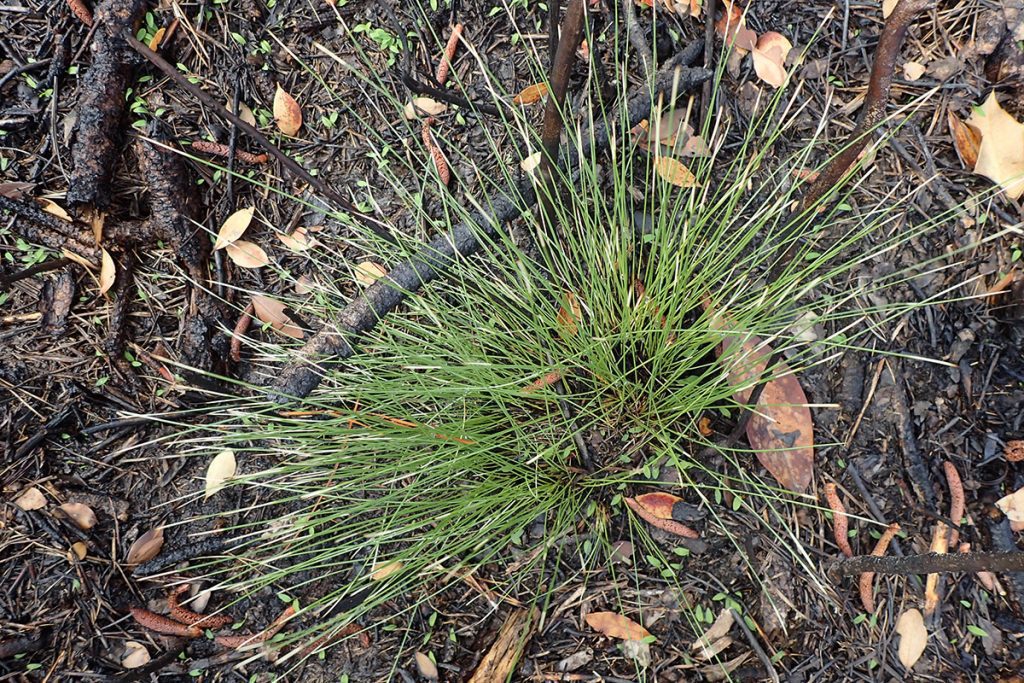
Wiregrass (Aristida stricta) after a burn. The burnt tips of the grass blades show what was visible of the plant just after the burn.
The Cypress Creek Crossing
We walk a couple of miles before we reach the crown jewel of this section of the Florida Trail. “This is a 250 foot, elevated boardwalk we just finished maybe three months ago,” Bruce tells us of the Cypress Creek crossing. It was built by the US Forest Service, which oversees the Florida Trail, and local volunteers.
As someone who enjoys kayaking through cypress trees, I enjoy this alternative way of crossing the wetland. When shooting video of the hikers walking down the boardwalk, it doesn’t take long to lose sight of them through the trees.
That to me is the allure of swampy areas, navigating a maze-like landscape with the potential for getting lost. But while the Florida Trail can be hard to follow in the Bradwell Bay Wilderness swamp when it’s wet, there’s only one way here.
“One of the key things on the Cypress Creek crossing is the Choctawhatchee River level,” Bruce says. Cypress Creek is part of the Choctawhatchee River floodplain, and its level corresponds to the river. “Our boardwalk is set for thirteen feet. Today, we’re only about eight feet.”
You can check the river level using NOAA’s Choctawhatchee River gauge for nearby Ebro, Florida. Bruce tells us that they plan on adding handrails which would let hikers cross even when the boardwalk is underwater.
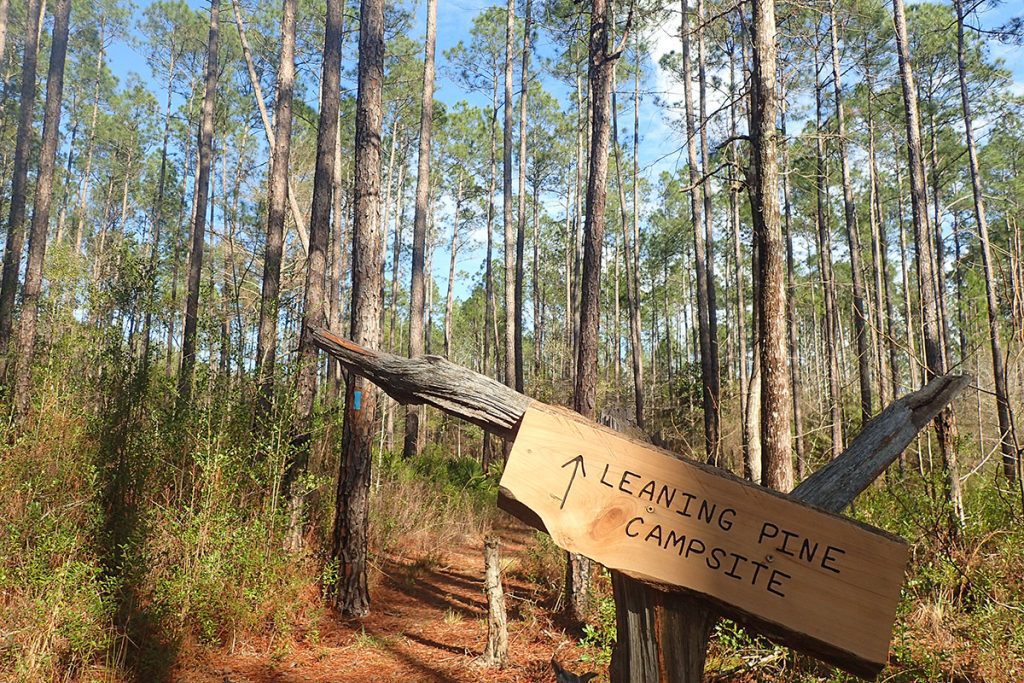
The Leaning Pine Campsite. Bruce Varner took great care to line the sign up with a leaning pine tree in the distance.
Customizing your Florida Trail Hiking Experience
There are two campsites on this 8.3 miles of trail. And, there are parking lots at both ends of the stretch. This gives you some options when you plan your hike on this trail section.
“So you can do a hike through,” Bruce says, “or a hike in, camp, and hike on out. So it makes it very accessible.”
But you don’t have to limit your hike to a day or two. The Florida National Scenic Trail runs over 1,000 miles between the Big Cypress National Preserve in the Everglades to Gulf Island National Seashore by the Alabama border. The US Forest has a handy online map that lets you look over the entire trail. It indicates campsites and trailheads, as well as alternate paths in a few locations.
So, you can plan on a day, a weekend, or a week. Or like Mary McKinley, you can hike the whole thing. Through-hiking season usually begins in October and runs through April. Aside from the logistical planning involved in living out of a backpack for months on end, you have to account for the fact that there aren’t always campsites along the way.
You can find tips and resources about through-hiking on the Florida Trail Association website.
The Apalachee, Panhandle, and Choctawhatchee chapters of the Florida Trail Association
You get a small taste of the work that went into 8.3 miles of trail in the video above. And they’re not done- trails have to be maintained lest they fall into disrepair. Trees fall across trails, and the bridges and boardwalks they built will need attention after a few years.
Of course, this is only 8.3 miles of trail. The entire 1,000+ miles of the Florida Trail is maintained by Florida Trail Association volunteers. The FTA is organized into 18 chapters, each responsible for multiple counties. The are four FTA chapters in the WFSU viewing area.
The Suwannee Chapter is responsible for Dixie, Lafayette, Suwannee, Columbia, Hamilton, Taylor, and Madison counties.
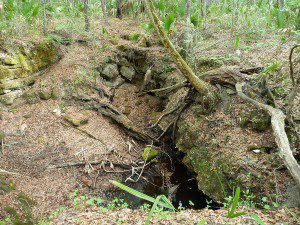
A little bit of the Aucilla River pops up in a karst window on the Aucilla Sinks section of the Florida National Scenic Trail.
The Apalachee Chapter looks after Jefferson, Wakulla, Leon, Gadsden, Liberty, and Franklin counties. Here, the Florida Trail runs through a lot of protected land, such as the St. Marks National Wildlife Refuge and the Apalachicola National Forest. We’ve had some great adventures here, hiking through the Aucilla River Sinks, the Cathedral of Palms and along the Sopchoppy River, and in the Bradwell Bay Wilderness.
The Panhandle Chapter cares for Gulf, Calhoun, Jackson, Bay, Washington, and Holmes counties.
The Choctawhatchee Chapter maintains Walton and Okaloosa counties. The section we toured in the video is part of a 19 mile stretch running through Northwest Florida Water Management District and Nokuse Planation land. They also maintain a 60 miles of trail on Eglin Air Force Base, which contains some old growth longleaf forest.
If you live in any of these areas, you might want to look at the chapter websites for events or organized hikes.
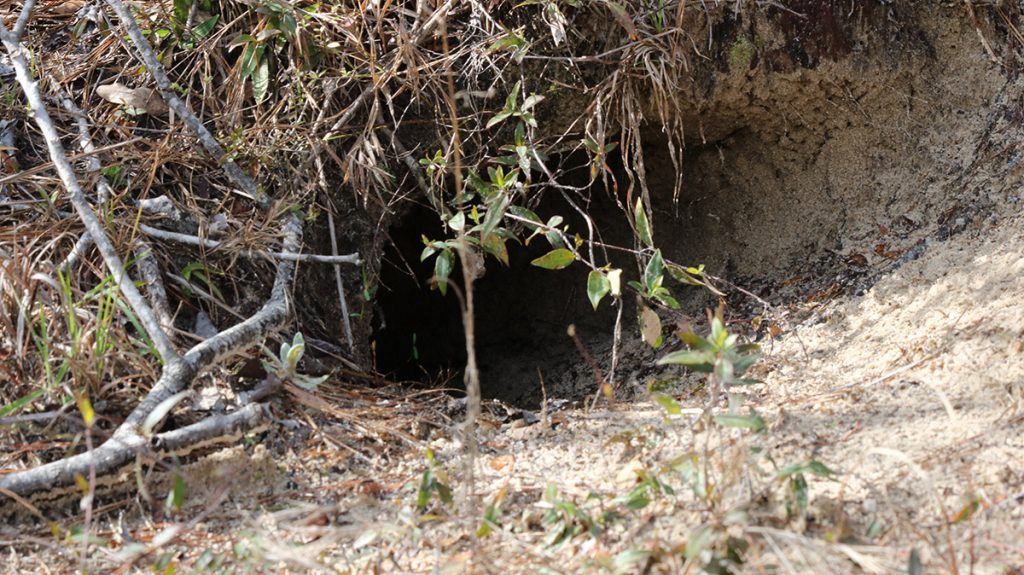
Gopher Tortoise burrow on the Nokuse Plantation section of the Florida Trail. The gopher tortoise is a keystone species of the longleaf ecosystem, and is vulnerable to habitat loss.
The Nokuse Plantation | A 300 Year Project
Our EcoAdventures take us through a lot of protected land. The amount of conserved habitat we have in north Florida is an asset to those of us who live here. Much of that is federal or state land. Hiking through the Nokuse Plantation, however, we’re on a large private preserve.
M.C. Davis established the planation in 2000. In a 2015 NPR story, Davis recounts growing up poor in the Florida panhandle. Davis was a professional gambler who made hundreds of millions of dollars investing in land and mineral rights. Eventually, his land purchases went towards the creation of a 53,000 acre environmental restoration project: the Nokuse Plantation.
He spent $90 million buying the land and planting it with 8 million longleaf pine trees. The sections we saw are in an earlier stage of restoration than on other areas of the plantation. However, they’re working on a long term time table. Second growth longleaf forests take hundreds of years to become anything like the ecosystems that had been cut down. Davis considers the Nokuse Plantation a 300 year project.

